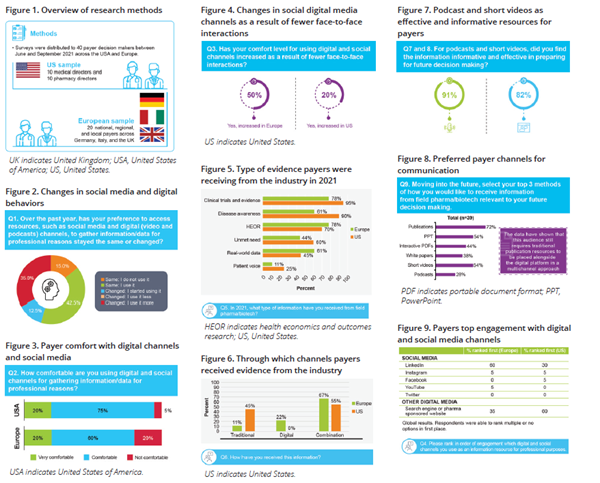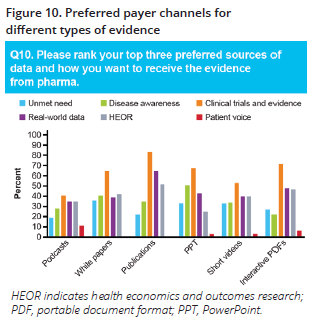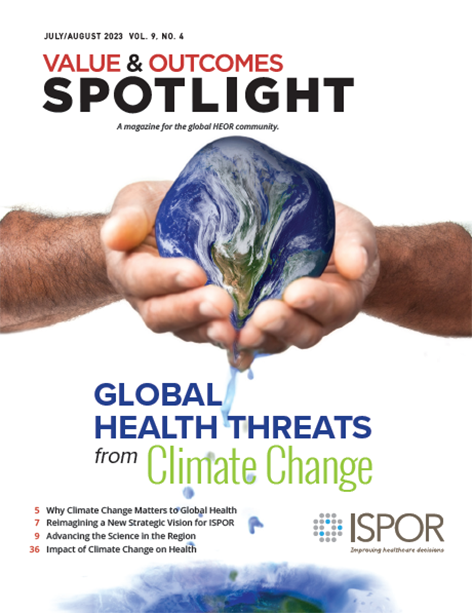HEOR Articles
Study to Investigate the Adoption of Digital Media by Global Payer Audiences in Their Assessment of Evidence
Sue O’Leary, BSc Pharmacy, Jenny Blackham, MPH, George Miles, BSc, and Michelle Collins, BA; Prime Global, Knutsford, England, United Kingdom
Background
The healthcare industry has seen a significant increase in the development of new technologies aimed at providing targeted therapies for specific patient populations. For instance, in just 1 year, there was a 47% increase in global research and development (R&D) products for gene therapy and 78% growth in R&D products for cell therapy.1
This quick pace in new technology advancement has presented a challenge for payers in understanding the value of such interventions. To address this challenge, the industry has been using a combination of traditional channels (publications and PowerPoint) and novel digital media (podcasts and videos) to explain and demonstrate how new science is addressing an unmet need. When the scientific foundation of a new complex mechanism of action is articulated in a compelling and informative way in publications and beyond, it builds the fundamental knowledge needed to be able to digest the product value story, which is essential for obtaining optimal market access. Alongside these therapeutic and diagnostic developments, we have also seen a shift in the adoption of communication channels, moving from traditional channels only, such as publications and evidence dossiers, to increasing engagement with emerging digital communication platforms, including social media networks.
Previously, digital channels have not been considered typical for value and evidence communication exchange between market access and health economics and outcomes research (HEOR) teams, payers, policy makers, and health technology assessment (HTA) bodies. However, the restrictions on traditional interaction surrounding the COVID-19 pandemic accelerated the adoption rates of these digital channels as people sought virtual alternatives to review evidence. This shift in how scientific value is now being exchanged among various stakeholders is creating a new window of opportunity for innovative digital engagement.
"We have also seen a shift in the adoption of communication channels, moving from traditional channels only, to increasing engagement with emerging digital communication platforms, including social media networks."
Our study sought to evaluate the openness of payer audiences to receiving information via digital and social media compared with traditional methods, and their future preferences for receiving communications.
Methods
Two third-party payer recruiters with networks of more than 100 participants were used to recruit payers across Europe and the United States. The payers were able to enroll into the study if an opening was available based on predefined payer types/roles: United States (types: national, regional, and integrated delivery network; roles: pharmacy and medical directors) and Europe (national, regional, and local). The respondents in the study were determined by a first-to-respond method. The payers were asked to complete an online survey via the third-party platforms made up of 10 questions focused on digital media, social media, and the types of evidence and dissemination channels that they used at the time of the survey and expected to use in the future. The question formats were a mixture of open-ended and multiple-choice answers.
Between June and September 2021, 40 payer decision makers across Europe and the United States took part in the survey. Twenty respondents were based in Europe, representing national, regional, and local payers across Germany, Italy, and the United Kingdom, and 20 were from the United States (10 medical directors and 10 pharmacy directors) (Figure 1).
Summary of Results
In Europe and the United States, 80% of payer respondents were comfortable using digital media to gather information/data for professional reasons (Figure 2). Half of payer respondents in Europe indicated they used digital media more frequently since the onset of the COVID-19 pandemic, compared with a 20% increase reported by US payer respondents, who indicated that usage was already high (Figures 3 and Figure 4).
Payers received a variety of different information from pharmaceutical companies in 2021, most commonly through a combination of traditional and digital channels (Figures 5 and 6), as opposed to one channel alone, and payers considered podcasts and short videos effective and informative resources in preparing for future decision making (Figure 7).
"Half of payer respondents in Europe indicated they used digital media more frequently since the onset of the COVID-19 pandemic, payers considered podcasts and short videos effective and informative resources in preparing for future decision making."
When looking at channels for future communication, traditional publications continued to be regarded as a priority (ranked in the top 3) for 72% of respondents. In addition, there was interest in a range of alternative media, including short videos (54%), PowerPoint decks (54%), interactive PDFs (44%)—which incorporate different types of media content, such as links, audio and video files, images, clickable buttons, and fillable forms—and podcasts (28%; Figure 8).
Of the social media platforms currently available, LinkedIn was ranked the highest information resource used by payers for professional purposes (Figure 9). Social media platforms ranked included Instagram, YouTube, Facebook, Twitter, and LinkedIn.

We investigated whether digital media was more suitable for specific types of information and our survey found that while publications remained the preferred source for conveying clinical trial evidence (84%) and real-world data (64%), information on disease awareness, unmet need, and health economics might preferentially be communicated via a range of different digital media formats (Figure 10).

Country Variations:
• Half of payer respondents in Europe indicated they used digital media more frequently since the onset of the COVID-19 pandemic versus 20% in the United States.
• Short videos were the second most popular format for European payer respondents after traditional publications (voted in the top 3 by 63% respondents in Europe compared with 40% in the United States).
Limitations:
• The relatively small sample size, particularly within specific countries and types of US payers, may limit extrapolation to diverse types of payers.
• There is a potential recruitment bias of digitally focused payers as the study was conducted online via a survey and was determined by first to respond.
Discussion
As introduced above, we know that the COVID-19 pandemic caused information and digital fatigue and sped up the adoption of digital and social media in our industry. Pharmaceutical stakeholders are turning to online methods for communication: McKinsey
reported that there was a 70% reduction of personal promotion in September 2020 from before the COVID-19 pandemic.2 We have seen that healthcare professionals can be active on Twitter, particularly for medical specialties where new evidence is being released at lightning pace. Meanwhile, patients are forming groups on Facebook to share and learn from their peers who live with the same conditions. This leads us to ask: “Where are the payers?” We learned from this research that payers do not have an established social media home like healthcare professionals and patients, but if they were going to engage with a channel, it would be LinkedIn.
"There are broader opportunities to utilize digital communications with certain payer stakeholders across markets."
This lack of a social media home may be because many countries have rigidly structured processes and templates for formal HTA submissions and hospital pharmacy and therapeutics committee reviews. Furthermore, market access teams may be apprehensive to foray into new, legally unchartered domains, given the uncertainty around social media from an internal and external viewpoint.
However, there are broader opportunities to utilize digital communications with certain payer stakeholders across markets. While information exchange in some countries follows regulatory approvals, there are policies in some countries to communicate ahead of launch, such as the US Food and Drug Administration preapproval information exchange3 and the UK PharmaScan system.4
Social media is only one avenue we explored in this research. We also explored digital formats, such as podcasts, interactive PDFs, and short videos. For digital formats the type of evidence shared via these media did matter. For example, using video technology coupled with a creative thought process can be an effective way to bring the payer on the journey from identifying the eligible patient to how the mechanism of action, when used in the right patient, translates to positive efficacy outcomes and manageable safety profiles.
With the rise in popularity of podcasts, we found that this digital medium can be leveraged to share new evidence, particularly around disease awareness, unmet need, and health economics. Payers are people and learning styles are not one-size-fits-all so employing a range of media formats has the potential to enhance communication with a diverse payer audience.
Based on our experience working with affiliates across markets, it is important to understand local compliance guidelines to ensure that appropriate channels are able to be leveraged. Also, new evidence disseminated from market access and HEOR digital initiatives needs to be aligned with industry guidance and national policy, as well as appropriate messages for the stage of the product life cycle. Lastly, we have learned that if the evidence being shared via a podcast or video is derived from a publication, which the payer can access to go deeper into the data, then the medium and content have more credibility.
Therefore, it is vital that digital media is nimble and flexible to ensure the right value story is being presented to the right decision maker at the right time, leading to positive patient access, which in turn will drive improved patient outcomes.
Conclusions
The study demonstrated that payer audiences saw value in receiving information via a variety of digital media alongside more traditional formats. Within each of the countries represented, there was a notable variation in the preferences of payers for the type of media, demonstrating that a multichannel communication approach is required to meet the preferences of a broad audience. Across all countries surveyed, the United States and the United Kingdom showed the most favorable response to digital media, and Germany was the least favorable.
References
1. Lloyd I. Pharma RD Annual Review 2020 White Paper. Citeline. Accessed January 31, 2023. https://pharmaintelligence.informa.com/resources/product-content/pharma-rdannual-review-2020-whitepaper
2. Mlika A, Mong J, Peters N, Salazar P. Ready for launch: reshaping pharma’s strategy in the next normal. McKinsey & Company. Published December 15, 2020. Accessed January 31, 2023. https://www.mckinsey.com/industries/life-sciences/our-insights/ready-for-launchreshaping-pharmas-strategy-in-the-nextnormal
3. AMCP. Pre-approval Information Exchange (PIE). AMCP. Accessed January 31, 2023. https://www.amcp.org/policy-advocacy/legislative-regulatory-issues/preapprovalinformation-exchange
4. UK PharmaScan. What is UK PharmaScan? PharmaScan. Accessed January 31, 2023. https://www.ukpharmascan.org.uk
Disclosures
All authors are employees of Prime Global, a market access and medical communications agency. Recruitment of payers was conducted by DeFacto Research Ltd in Europe and InCrowd Inc in the United States.

